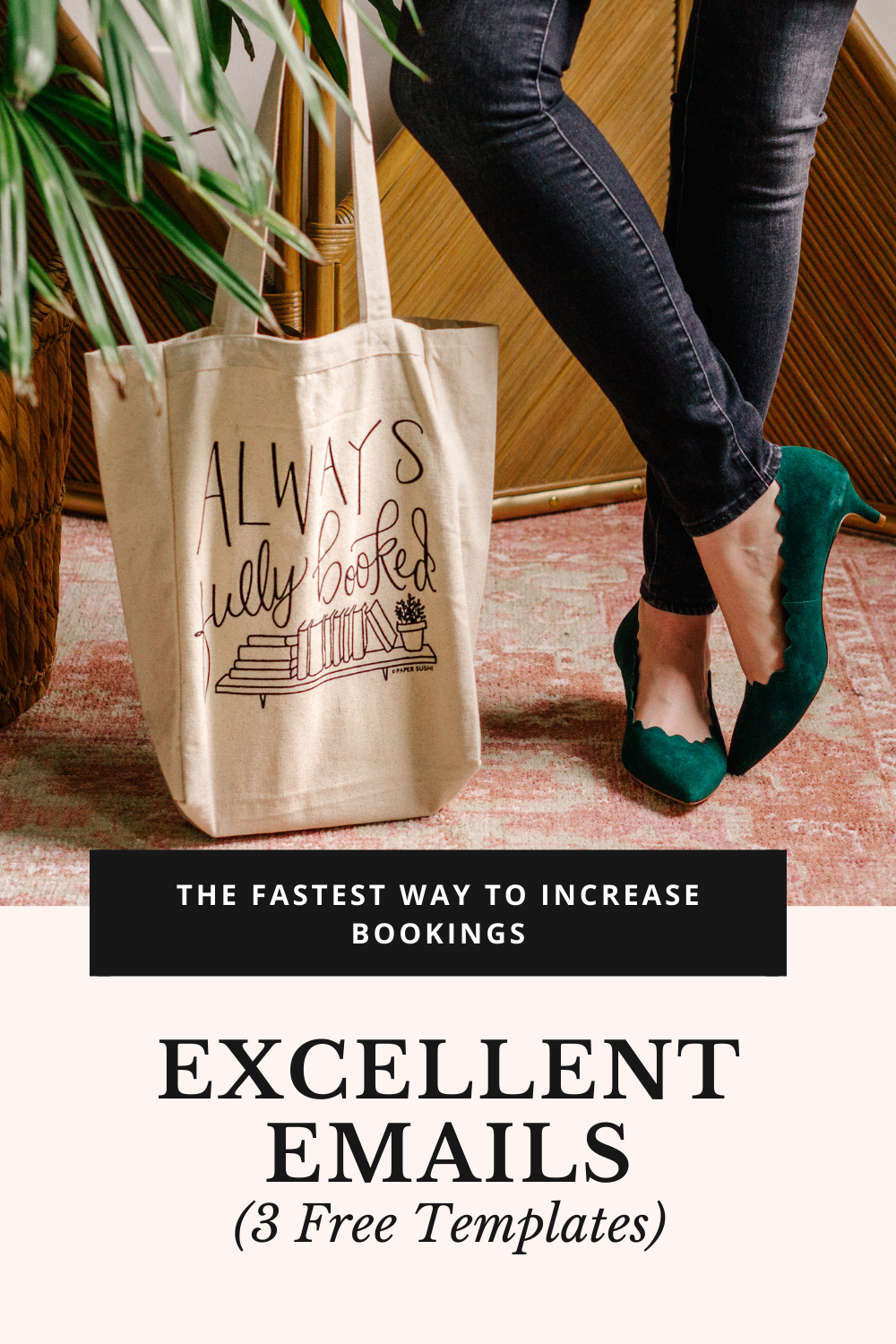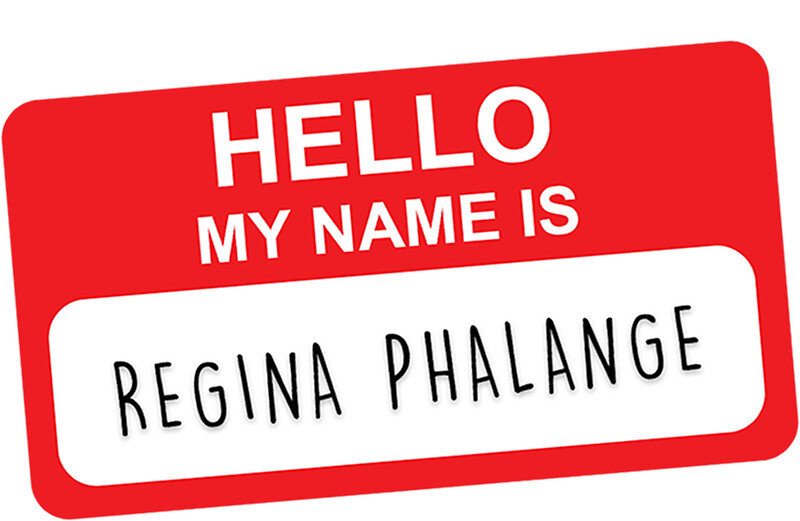The Fastest Way to Increase Client Bookings: Excellent Emails!
How many times has your day been dampened by a dry, abrupt, or impersonal email?
Apart from the customer service emails I get from giant companies, where all support is outsourced to call centers in Bangladesh and I expect it to be terrible, I have a high standard for email correspondence. This holds doubly true when I write to any personality-based brand.
When I say “personality-based,” I mean a coach, nutritionist, copywriter, photographer, podcaster, blogger, designer, stylist, or any other person whose face is their brand. If I know there’s a real person on the other end of an email, someone who built a business from the ground up with just scrappiness and passion, then I expect to gauge what it’s going to be like to work with that person from the quality of our email interaction.
In the last 20 years, we’ve seen business email communication go from a place of complete professionalism—emails written in full sentences, opened and closed with salutations, double-checked for spelling and punctuation—to a place where emails and text messages can work together, one-word emails are often commonplace, and even serious e-documents like pitch letters can contain emojis.
This transition has created a gray area on what’s acceptable when it comes to responding to inquiries, establishing relationships, and building collaborations. No one seems to be educating new business owners on how this one pocket of their business can provide a real leg up when it comes to client acquisition, if done well, or become one of the biggest holes in a company for hemorrhaging money.
So I’m taking up the baton. I’ve carefully whittled my list down to 7 ways to provide a great email correspondence experience, all of which I currently use in my business. (And for the record, I have nearly a 100% success rate of turning inquiries into paying clients.) As a bonus, I’ve also crafted 3 email templates you can download and customize for your own business, attached to the bottom of this post.
Ready to change the way you do business for the better? Read on.
TIP #1 - SHOW SINCERE INTEREST IN THE PERSON YOU’RE WRITING TO.
Many of my clients come to me via the contact form here on my website. They run a search, find my site, want to know more, and take 30 seconds to fill out a super standard form to get in touch.
When I say “standard,” I mean that the fields of the form are pretty basic: Name, email, subject, message. But these four fields are all I need to extrapolate enough information to write a highly personalized response.
For example, when someone writes to me about wanting photos for a photography subscription, they’re likely to be writing me from a business email address (mary@businessname.com). This means I can see what domain they own (businessname.com). In just 2-3 minutes, I can pop that address into my search bar and browse the website enough to get an idea of what the business is like.
I always do this! Why? Because I can use that information to guide my response to the potential client: “I visited your site. Wow! Your business seems really cool. I especially like…”
This does two things: One, it opens the door for the other human being to tell me more about something that really lights them up and makes them happy—their business! Two, it makes that person feel like we already know each other—because I’ve shown interest in them enough to go out and learn about something they’ve poured their heart and soul into.
Now, you may not work with businesses, like I do, but you can probably find one thing in every email inquiry that you can turn into a conversation piece, something that centers on the other person. And you want to do this to establish relationship from the very beginning. Relationship shifts the conversation out of whether or not to hire you, and into what happens next in the process.
TIP #2 - KEEP YOUR EMAILS BRIEF… BUT NOT TOO BRIEF.
When it comes to email, you can safely assume that a lot of people who correspond with you are viewing your messages from their phone or work tablet, and that they might be in a hurry or distracted by the many other browser tabs they have open; and therefore you don’t want to give them too much to process, or they’ll just tune you out.
However, this is strangely why taking the time to craft an email that sounds like a real person talking is imperative.
You can keep an email brief and still speak to the person you’re talking to as though they’re standing right across from you. Remember, the people you write to are in a hurry and distracted because everyone around them is yelling for their attention. If you can provide a calm, steady, courteous tone in your conversation, you’re going to be the person they want to give their time to, because you make them feel like they matter and someone is actually happy to be talking to them.
Take the extra few seconds to say something pleasant at the start of every email, and to write in full sentences, even if those sentences are short. “Info attached” is a lot colder than, “In case I missed anything, I’m attaching our package options and FAQ sheet. You’ll find the most helpful information on the second page of the package options.”
My rule of thumb? It should take longer to drink a good cup of coffee than read an email, but it should be just as pleasant!
TIP #3 - REMEMBER THAT THE OTHER PERSON CAN’T SEE YOUR FACIAL EXPRESSIONS, SO YOU HAVE TO COMMUNICATE ENTHUSIASM (AND ALL EMOTIONS) IN OTHER WAYS.
I can’t tell you how often I receive emails from established professionals that don’t include any question marks, exclamation points, or other indicators that the other person is fully engaged in the topic at hand.
Emoticons and emojis were invented because when we communicate electronically all the time, two big parts of normal conversation goes missing—tone, and body language. While we may not all feel comfortable using these handy little tools in our businesses, the fact remains the same that written language, when formed carelessly, can feel cold and impersonal, which can put our clients and potential clients in a state of unease.
In order to demonstrate to your potential clients that you care, you want to be cognizant of what it will feel like to read your message for the first time. Which of the following responses “sounds” better on the screen?
“That time works.”
“Works for me! Really looking forward to it.”
Notice that I didn’t have to use any emojis in the second example to convey a positive response. It’s also not that much longer, and it builds a sense of eagerness for the upcoming interaction, rather than letting the event fall flat.
Another tip here: Avoid negative language like the plague. Rather than using phrases like, “That won’t work,” “I can’t,” or “Not on my end,” steer instead toward things like, “I’m booked up at that time but I could do the afternoon,” and “Since I’m not available on Sundays, I’ll need to work with you to find an alternate time; how about Tuesday?”
TIP #4 - ALWAYS GREET THE OTHER PERSON BY NAME.
This one is so simple, I’m shocked that more people don’t do it.
Nearly every client email I send starts or ends with me addressing the opposite person by name: “Hey, Stephanie! Thanks for getting back so quickly,” or, “Morning, Tom!” or, “You’re the best, Kate. See you Thursday!”
I look at every email, unless I’m going back and forth many times in the same day with a single person, as a fresh correspondence. I intentionally re-establish the positive tone I set in previous emails in order to calibrate the current message to my usual standard. I never know what kind of day my client is having, and I want to be a beam of light no matter what.
Using the other person’s name is a fast, personal, simple way to do this. In the words of Dale Carnegie in How to Win Friends and Influence People, “A person’s name is to that person the sweetest, most important sound in any language.” By acknowledging your client, or potential client, by name, you’re reminding them that they have your full and complete attention—that you “see them”—and that you’re an important person in your business.
Try to address your clients and potential clients by name in every email you write.
TIP #5 - TELL THE RECIPIENT EXACTLY WHAT YOU WANT THEM TO DO NEXT.
When it comes to “what’s next,” never leave any room for ambiguity in your emails, either with clients or prospective clients. Keep the conversation flowing, and encourage the other person to respond to whatever information you’ve sent by action—either so you can secure them as a client, or so that the project you’re already working on together continues to move along swimmingly.
To do this, always slip a Call to Action in at the end of every email. A Call to Action is a sentence or phrase that instructs the other person and gives them confidence that you’re in control. Examples include, “Send me your answer,” “Add your comments to the Pinterest board,” “Sign the attached agreement,” and so on.
Usually, if someone has hired you as a professional, on some level they assume you have a process, and they’re deferring to you to lead in your relationship once they’ve hired you. They’re waiting for you to tell them what happens next, including what you want from them—so do it!
TIP #6 - TRY TO HAVE THE FINAL WORD. NEVER LEAVE THE OTHER PERSON HANGING.
Sometimes clients will send you feedback you don’t like; they’ll send you information or content you don’t need yet in your process; or they’ll send you exactly what you need and both of you know it, so there doesn’t seem to be any reason to respond.
Contrary to the sensation you may have that you don’t need to respond, almost always it is a good idea to respond, anyway. I’ve sent many an email that read, “Just acknowledging that I received this. Thank you for sending it over!” This leaves nothing to the other party’s imagination, including just whether or not you’ve opened their email yet.
By responding to all your emails, you send the subconscious message that you’re not too busy for your clients (or prospective clients), and that you’re reliable in the communication area. This will put your clients at ease for more of the process of working with you, which in turn leads to a better feeling overall, which can translate to referrals and positive reviews down the line.
I will say that if you’re getting inundated with emails from a particular client, restricting the times of day you respond (not responding on weekends or in the evening) can be wise. Just let your client know you only respond to emails during “office hours.” Side benefit: This also gives you time to cool down if you get an email that makes you hot under the collar, so that you don’t respond emotionally.
TIP #7 - FOLLOW UP. FOLLOW UP. FOLLOW UP.
My client base is a 70/30 split of people who respond to all my emails swiftly, and people who see my emails, have the best intentions to respond later, and then totally forget to email me back.
For those 30% who don’t email me back right away (and this includes prospective clients), I’ve gotten really, really comfortable sending cheerful follow-up emails. Usually I don’t wait more than 2 business days to send them.
It is never my intention to pressure anyone with a follow-up email—only to keep our conversation top of mind. My messages always start by addressing the person by name, and then stating right away, “Just following up on our most recent conversation…”
Almost always, the other person responds by thanking me for reminding them, and then they take the action I’ve asked them to take.
Was this article helpful? If so, make sure to pin it so that you don’t lose it! And as always, I love when you share the best piece if insight you gleaned by leaving a comment below the article. I can’t wait to chat with you!
Oh, PS—Here are your 3 free email templates! Download them all by clicking here. And to learn more about client communications and staying organized in business, discover HoneyBook!
HELLO! MY NAME IS ALEXIS.
Coffee lover, day dreamer, foodie, and creative. I believe in doing what you can with what you have where you are. I blog to help you do more with what you have. I hope you love it here!


























